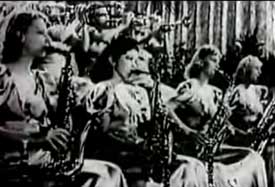 Rita Rio & her Mistresses of Rhythm was an all-women swing band, among the best of the 1940s.
Rita Rio & her Mistresses of Rhythm was an all-women swing band, among the best of the 1940s.
Because critics had a habit of reviewing the looks of the musicians instead of their musicianship, Rita became noted for what amounted to feminist consciousness-raising in radio interviews.
She eagerly upheld the musicianship of the women of her band, at a time when other women bandleaders just bore up without complaint.
Her band's soundie I Look At You (1941) closely resembles a film clip because it's so richly textured visually & because the lead vocalist is Alan Ladd, & odd to think he wasn't yet associated with starring film roles.
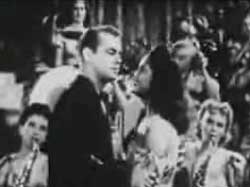 Rita is pretty, young, petite, bounces as she conducts the gals. Just as as many an all-boy band had a gal come out for the lead vocals, Rita has Alan Ladd stroll center stage to join her at her side. Rita is pretty, young, petite, bounces as she conducts the gals. Just as as many an all-boy band had a gal come out for the lead vocals, Rita has Alan Ladd stroll center stage to join her at her side.
He gazes into Rita's eyes as he begins singing, quite nicely, a lyric that invites mini-solo close-ups of specific band members:
"I look at you & the trumpet plays so sweet/ I look at you & the drum begins to beat/ I touch your hand & the whole darn band begins to play/ Then my old poor heart sets into swing & sway..."
After the line, "There's music in my heart when I look at you," Rita in a big flowing gown dances about with great skill, holding up the edge of her skirt. What a talented gal! And Alan wasn't bad either, having taken Rita's baton to conduct the band as she dances us out.
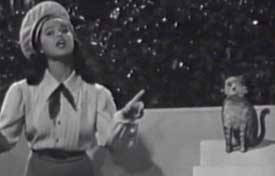 Piopular bandleader Rita Rio later in the movies in straight acting roles she reverted to her original name Dona Drake. Piopular bandleader Rita Rio later in the movies in straight acting roles she reverted to her original name Dona Drake.
She must've really loved the name Rita, though, since early in her career she also went by Rita Ray & Rita Shaw.
Rita Rio & Her Mistresses of Rhythm are dressed as military personel -- nurses & waves -- performing in the Home for the Aged in Feed the Kitty (1951). This orchestra includes a full sized harp -- used to fine jazz effect.
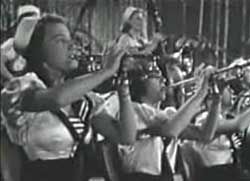 Rita moves with the grace of a Cab Calloway keeping the jumpin' beat & lithe as a serpentess. Rita moves with the grace of a Cab Calloway keeping the jumpin' beat & lithe as a serpentess.
Halfway through the lively instrumental, Rita begins singing with surprising insinuation:
"Please feed the kitty/ Oh mister have pity on her. Meow/ Please feed the kitty/ So new to the city, she'll purr. Meow/
"Come kitty-kitty-kitty-kitty, my kitty-kitty-kitty-kitty, my pretty pet/ Come kitty-kitty-kitty-kitty, nice kitty-kitty-kitty-kitty, take all you can get..."
There's an obvious double entrandre, but the kitty is also shown to be a donation box. Coming in on the close, the band starts in on a jungle rhythm borrowed from Duke Ellington, then all the old folks in the home leap out of their wheelchairs onto the floor for some jive dancin'. Great little soundie!
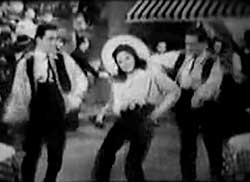 Another soundie for the dydamic Rita Rio again looks like sheis peforming in a film clip though it isn't; Pan-Americonga (1941) is a complete mini-film. She's not with her all-girl band but with Carlos Fernando & His Mexican Orchestra. Another soundie for the dydamic Rita Rio again looks like sheis peforming in a film clip though it isn't; Pan-Americonga (1941) is a complete mini-film. She's not with her all-girl band but with Carlos Fernando & His Mexican Orchestra.
It was also filmed on one of the sets for Pot o'Gold (1941), with Pan-Americonga making use of the same dancers seen in the feature film. Pot o'Gold was directed by George Marshall the director of Blue Dahlia (1946) starring Alan Ladd.
I don't think anyone really knows for sure who directed Rita Rio's 1941 soundies, but I am guessing it was Marshall, though uncredited, & this accounts for the higher cinematic qualities of Rita's soundies, & certainly Marshall was familiar with low-budget musicals.
Rita's wearing a nice Latina costume & hat that aren't too gaudy while being nicely ethnic, as she takes the lead vocal while dancing between two hunky latinos in vests & poofy-shirts.
They're doing moves that are more like rhumba than conga. The number begins: "Gouchos from the pampas/ Co-eds from the campus/ All dance to the rhythm of the Pan-Americonga."
The setting is a cafe or small club with lots of patrons at tables, but they must be from a film lot, as the joke here is that the Pan-Americonga appeals to people of all nations. So at one table there's a cowboy with six-guns, at another a Native American with feathers & buskins, at another a cossack in national costume.
Soon all these varied folks are forming a conga line while Rita & her two gouchos dance a separate routine, & Rita's truly some dancer. The song itself doesn't completely overcome its novelty factor & really does come off as the themesong of some old Hollywood down-mexico-way musical comedy.
This soundie was included in the Castle Films home-projection one-reeler South of the Border Songs (1945). The other two films that became part of this anthology were Say Si Si (1941) featuring Ellen Connor with Herbie Kaye & His Orchestra, &My Linda Amor (1943) with Lucille Angel & the dance team of Fred & Mary Velascos.
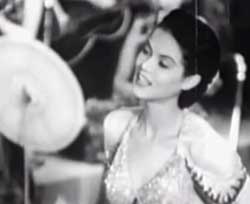 The title of Flying Feet (1942) alludes to the acrobatic tapdancer Anita Jacobi, who performs in a manic amazing manner through this sounding. The title of Flying Feet (1942) alludes to the acrobatic tapdancer Anita Jacobi, who performs in a manic amazing manner through this sounding.
She really does seem to be flying; she's off the floor such a high percentage of the performance.
After all this lively tapping & cartwheeling & flipping, the film focuses in on Rita Rio, svelt in shimmering silver gown, in front of her all-girl band, singing in Spanish a slow romantic version of "La Cucaracha," which I betcha never knew could be such a romantic number.
Before its through, "La Cucaracha" becomes an amazing jump-jazz number, with Rita managing some fabulous tapdance maneuvers even in the long tight gown. Gods she's good, almost too lithe to be strictly human.
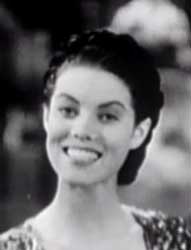 She combines the best of a bandleader like Cab Calloway with the coolest flappers of the Roaring Twenties, a personification of song in motion. She combines the best of a bandleader like Cab Calloway with the coolest flappers of the Roaring Twenties, a personification of song in motion.
Although Flying Feet & Sticks & Stones were released as soundies in 1942, as part of a "Musical Memories" series, in fact both of these soundies were both derived from Sweet Shoes; aka, Nu-Atlas Musicals: Sweet Shoe (1938), produced by Educational Film Corporation of America for 20th Century Fox.
The two soundies were issued by Talk-a-Vision, a shortlived rival to the Panoram jukeboxes. Together they constitute about half the full content of the 1938 film. I'd dearly love to see the whole thing.
In Sticks & Stones we're on the same set as in Flying Feet with Rita & her girls, as she sings a jump-jazz tune with such lyrics as:
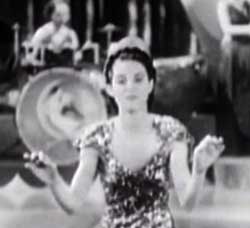 "Sticks & stones may break my bones/ But your names will never hurt me/ If my honey don't desert me/ I'll be satisfied..." "Sticks & stones may break my bones/ But your names will never hurt me/ If my honey don't desert me/ I'll be satisfied..."
It's a wonderful number performed with elegance & pizazs. Rita ends her performance of the lyrics with some amusing scatting then takes off tapdancing, while we hear the harmonies of a quartet called The Four Norsemen, not yet visible far stage left.
Then out strolls a quartet of tapdancers, The Four Specs. It was rare in those days to have black dancers surround a white singer/dancer, so this is a pretty hip moment.
Rita dances over to join the Four Norsemen in an amusing vocal; these white guys are chubby & wearing shoemaker aprons, which would perhaps have a context if we could get hold of the entirety of the original Sweet Shoes.
For big finale the Four Specs are dancing like the blazes; Rita rejoins the tap choreography; & the ultra-acrobatic tapper Anita Jacobi returns to the stage & begins cartwheeling in place over & over like a furious propeller. And good gracious ain't it sumpin!
copyright © by Paghat the Ratgirl
|
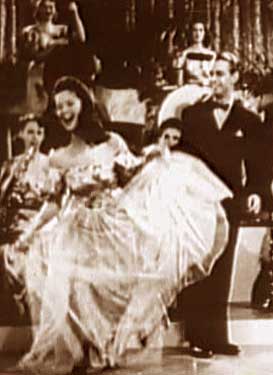

 Rita is pretty, young, petite, bounces as she conducts the gals. Just as as many an all-boy band had a gal come out for the lead vocals, Rita has Alan Ladd stroll center stage to join her at her side.
Rita is pretty, young, petite, bounces as she conducts the gals. Just as as many an all-boy band had a gal come out for the lead vocals, Rita has Alan Ladd stroll center stage to join her at her side.
 Rita moves with the grace of a Cab Calloway keeping the jumpin' beat & lithe as a serpentess.
Rita moves with the grace of a Cab Calloway keeping the jumpin' beat & lithe as a serpentess.
 She combines the best of a bandleader like Cab Calloway with the coolest flappers of the Roaring Twenties, a personification of song in motion.
She combines the best of a bandleader like Cab Calloway with the coolest flappers of the Roaring Twenties, a personification of song in motion. "Sticks & stones may break my bones/ But your names will never hurt me/ If my honey don't desert me/ I'll be satisfied..."
"Sticks & stones may break my bones/ But your names will never hurt me/ If my honey don't desert me/ I'll be satisfied..."